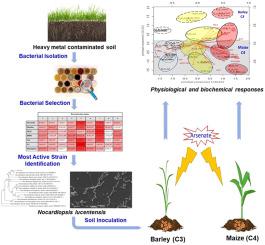Journal of Hazardous Materials ( IF 12.2 ) Pub Date : 2021-05-08 , DOI: 10.1016/j.jhazmat.2021.126055 Hamada AbdElgawad 1 , Gaurav Zinta 2 , Walid Abuelsoud 3 , Yasser M Hassan 4 , Dalal Hussien M Alkhalifah 5 , Wael N Hozzein 6 , Rafat Zrieq 7 , Gerrit Ts Beemster 8 , Sébastjen Schoenaers 8

|
Accumulation of arsenic in plant tissues poses a substantial threat to global crop yields. The use of plant growth-promoting bacterial strains to mitigate heavy metal toxicity has been illustrated before. However, its potential to reduce plant arsenic uptake and toxicity has not been investigated to date. Here, we describe the identification and characterization of a Nocardiopsis lucentensis strain isolated from heavy metal contaminated soil. Inoculation with this bioactive actinomycete strain decreased arsenic root and shoot bioaccumulation in both C3 and C4 crop species namely barley and maize. Upon arsenate treatment, N. lucentensis S5 stimulated root citric acid production and the plant’s innate detoxification capacity in a species-specific manner. In addition, this specific strain promoted biomass gain, despite substantial tissue arsenic levels. Detoxification (metallothionein, phytochelatin, glutathione-S-transferase levels) was upregulated in arsenate-exposed shoot and roots, and this response was further enhanced upon S5 supplementation, particularly in barley and maize roots. Compared to barley, maize plants were more tolerant to arsenate-induced oxidative stress (less H2O2 and lipid peroxidation levels). However, barley plants invested more in antioxidative capacity induction (ascorbate-glutathione turnover) to mitigate arsenic oxidative stress, which was strongly enhanced by S5. We quantify and mechanistically discuss the physiological and biochemical basis of N. lucentensis-mediated plant biomass recovery on arsenate polluted soils. Our findings substantiate the potential applicability of a bactoremediation strategy to mitigate arsenic-induced yield loss in crops.
中文翻译:

夜光诺卡氏菌的放线菌菌株可降低大麦和玉米中的砷毒性
植物组织中砷的积累对全球农作物的产量构成了重大威胁。以前已经说明了使用促进植物生长的细菌菌株减轻重金属毒性。但是,迄今尚未研究其减少植物砷吸收和毒性的潜力。在这里,我们描述了从重金属污染土壤中分离出的夜蛾Nonoopsis lucentensis菌株的鉴定和表征。接种这种具有生物活性的放线菌菌株可以降低大麦和玉米等C3和C4作物品种的砷根和芽的生物积累。经过砷酸盐处理后,卢森氏猪笼草S5以特定物种的方式刺激了柠檬酸根的产生和植物的先天解毒能力。另外,尽管大量的组织砷水平,该特定菌株仍促进了生物量的增加。砷暴露的枝条和根中的排毒(金属硫蛋白,植物螯合素,谷胱甘肽-S-转移酶水平)上调,补充S5后,特别是在大麦和玉米根中,这种反应会进一步增强。与大麦相比,玉米植物更能耐受砷酸诱导的氧化胁迫(较少的H 2 O 2和脂质过氧化水平)。但是,大麦植物在抗氧化能力诱导(抗坏血酸-谷胱甘肽周转率)方面投入了更多的资金,以减轻砷的氧化胁迫。S5。我们量化和机制讨论了砷污染的土壤上N. lucentensis介导的植物生物量恢复的生理和生化基础。我们的发现证实了细菌修复策略减轻砷引起的农作物产量损失的潜在适用性。










































 京公网安备 11010802027423号
京公网安备 11010802027423号